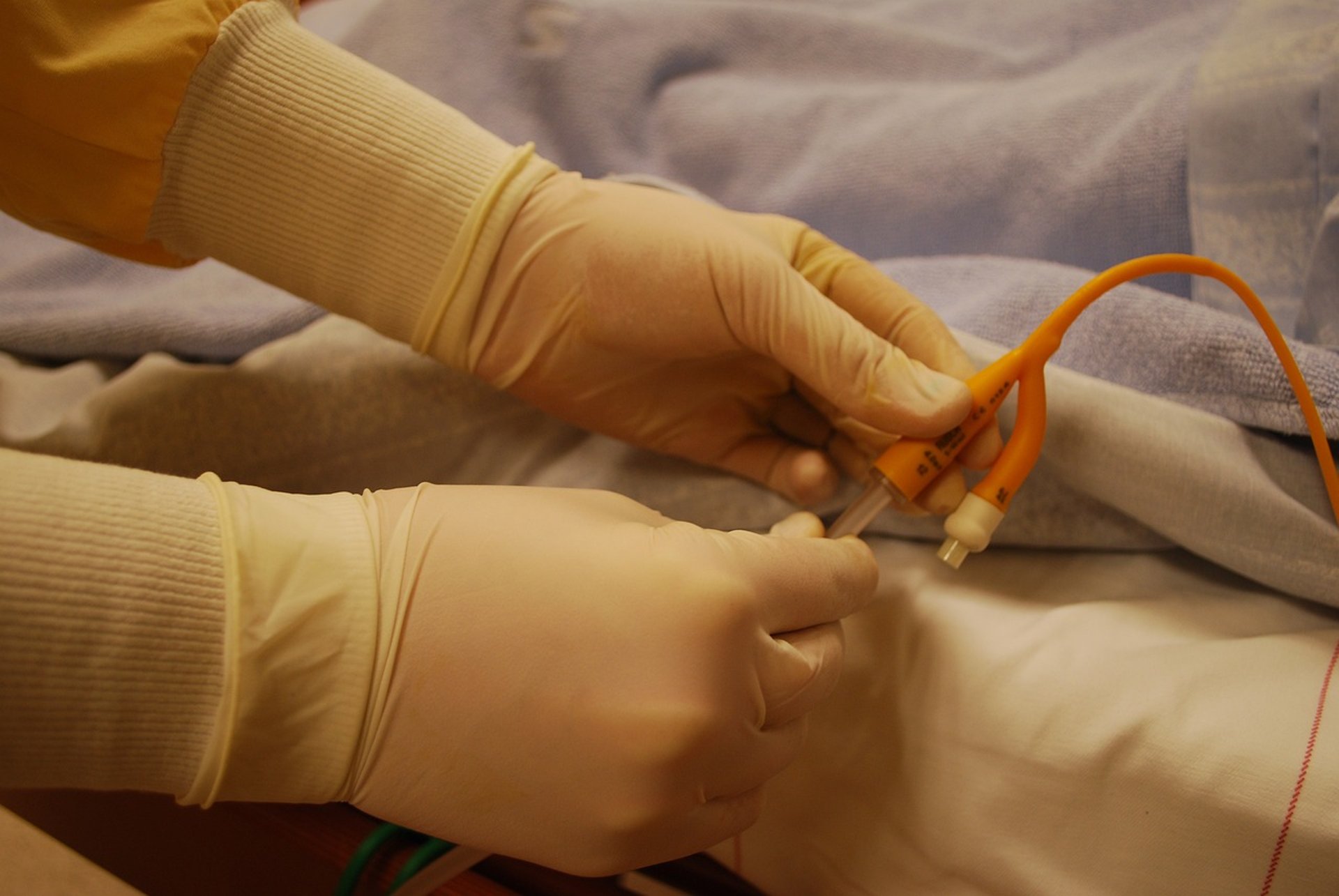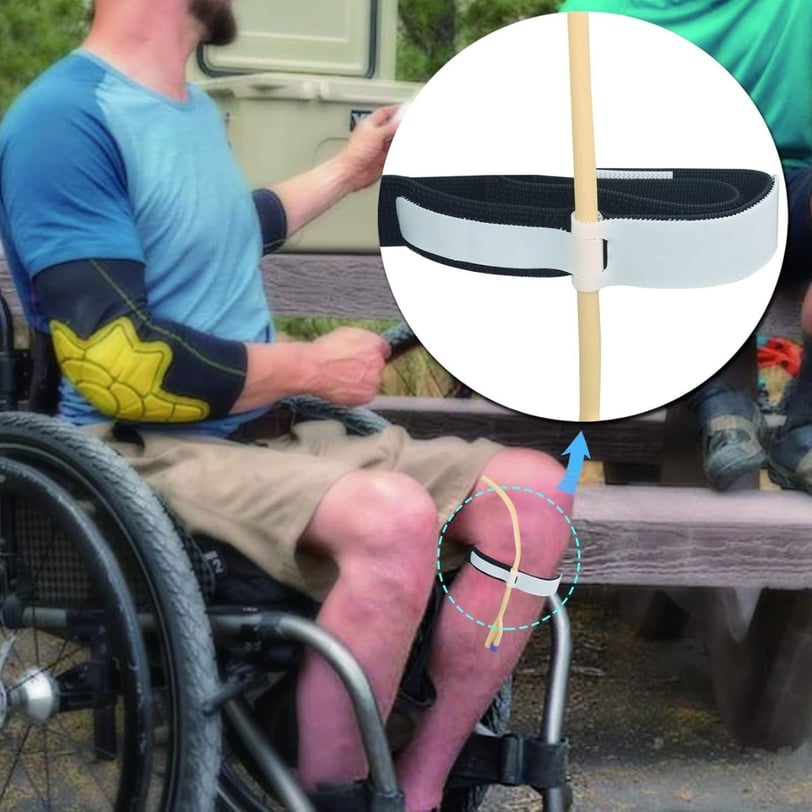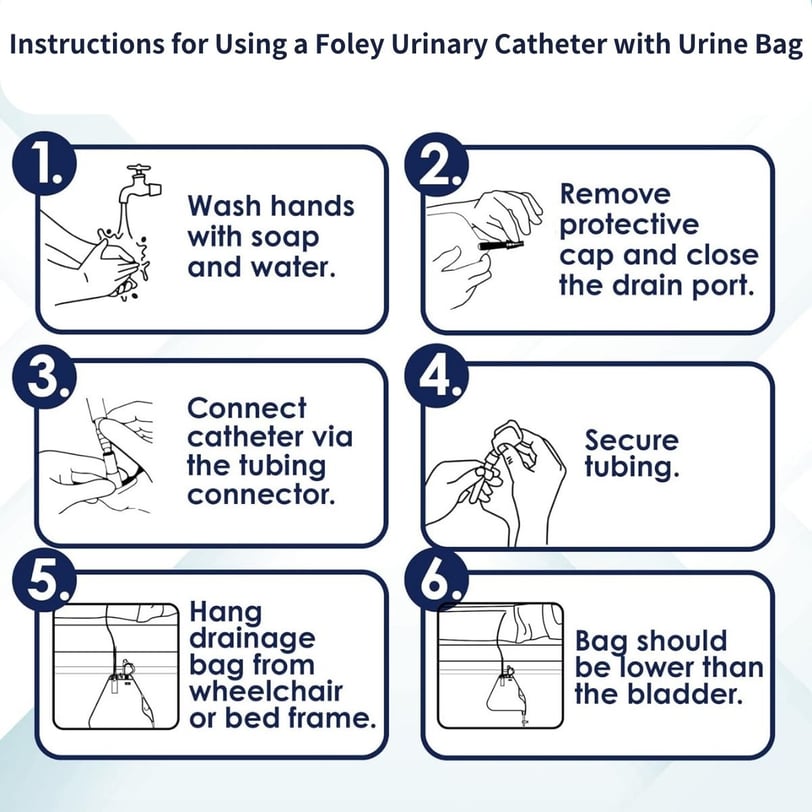
Continuous Catheterization: A Comprehensive Guide to Home Care and Management
Discover essential tips on continuous catheterization and urinary catheter care. Learn how to manage your catheter at home, prevent infections, and improve bladder health with practical advice.
INCONTINENCE CARE
Introduction
Managing bladder health with continuous catheterization can feel overwhelming at first, but it doesn’t have to be. Whether you're a patient or caregiver, understanding the basics of urinary catheter care is crucial for maintaining comfort and preventing infections. This guide will cover everything from catheter management at home to infection prevention and daily care routines.
If you or a loved one is dealing with urinary retention, incontinence, or requires a catheter after surgery, this article will provide you with the knowledge to handle continuous catheterization with confidence. Whether you’re using an indwelling catheter, intermittent catheter, or even a suprapubic catheter, you’ll find valuable information here to improve your catheter care at home.
Let’s dive in and make managing a catheter a smoother, more manageable part of your daily life.
Table of Contents
Types of Catheters Used
Comparison of Different Types of Urinary CathetersCaring for the Catheter at Home: A Guide for Patients & Caregivers
For the Patient
For the CaregiverPreventing Infections
Risk of Bacteriuria with Indwelling CatheterizationInstructions for Using a Foley Urinary Catheter with Urine Bag


Maria's first day with her new indwelling catheter was a whirlwind. She accidentally pulled it while trying to get out of bed, but her nurse was quick to help.
Why Continuous Catheterization Matters
Let’s demystify continuous catheterization—a medical procedure that may seem complex at first, but becomes clearer with a bit of understanding. This guide is here to walk you through the essentials of continuous catheterization, making it easier for you to manage at home and ensure optimal comfort and well-being.
Whether you’re newly diagnosed with a condition requiring catheter use or are caring for someone who is, knowing the basics and how to care for a catheter properly can make all the difference. Think of this guide as your go-to resource for clear, practical advice that helps you navigate this important aspect of medical care.
Who Will Benefit from This Guide?
Patients: If you’ve been advised to use a continuous catheter, this guide will help you understand its purpose and learn effective home management strategies.
Caregivers: If you’re responsible for someone with a catheter, you’ll find essential tips on proper care techniques, including infection prevention and maintenance.
What is Continuous Catheterization?
Picture your bladder as a small reservoir that fills up with urine. When it reaches capacity, your body signals the need to urinate. However, conditions can disrupt this natural process, making it challenging to empty your bladder effectively. That’s where continuous catheterization comes into play.
Continuous catheterization involves inserting a thin, flexible tube called a catheter into your bladder through the urethra (the tube that carries urine out of your body). This catheter acts as a drain, continuously collecting urine and directing it into a drainage bag.
Why Might Continuous Catheterization Be Needed?
Urinary Retention: This occurs when the bladder cannot empty fully due to conditions such as benign prostatic hyperplasia (BPH), nerve damage, or after surgery. It’s like a clog in your body’s drainage system that needs addressing.
Incontinence: For those with weak bladder muscles or neurological conditions that impact bladder control, continuous catheterization can effectively manage incontinence and maintain dryness.
Post-Surgical Care: Following certain pelvic surgeries, a catheter may be temporarily required to facilitate urine drainage while healing occurs.
Who Needs Continuous Catheterization?
Continuous catheterization is typically recommended for individuals whose medical conditions impair their ability to control or empty their bladder effectively. Let's take a closer look at some of the most common conditions where continuous catheterization plays a crucial role:
Spinal Cord Injuries: Damage to the spinal cord can interrupt communication between the brain and bladder, leading to a condition called neurogenic bladder. This makes it difficult or impossible to fully empty the bladder, necessitating continuous catheterization to prevent complications like infections or kidney damage.
Multiple Sclerosis (MS): MS affects the central nervous system, often causing bladder dysfunction. As the disease progresses, the nerves controlling the bladder may weaken, leading to issues like urinary retention or incontinence.
Parkinson's Disease: As Parkinson’s progresses, the degeneration of nerves that regulate bladder function can lead to an inability to fully empty the bladder, resulting in urinary retention or frequent urges to urinate.
Stroke: Stroke survivors often experience neurological damage that can impair the bladder muscles and the nerves that control urination. In these cases, continuous catheterization can help manage bladder function effectively.
Prostate Issues: Conditions like benign prostatic hyperplasia (BPH) or prostate cancer can cause the prostate to enlarge and press on the urethra, leading to urinary retention. A catheter can relieve this blockage and restore proper urine flow.
Diabetes: Diabetic neuropathy—nerve damage caused by prolonged high blood sugar levels—can affect the nerves that control bladder function, leading to incomplete bladder emptying or incontinence.
Cerebral Palsy: This neurological condition can cause abnormal brain and spinal cord development, often resulting in bladder control issues that require catheterization to manage.
Severe Mobility Issues: For individuals with limited mobility due to conditions like advanced arthritis or severe injuries, catheterization can be essential for managing bladder function, especially when regular trips to the bathroom aren’t feasible.


Catheter Leg Strap
Types of Catheters Used
When it comes to continuous catheterization, different types of catheters are available to suit individual needs. Here's a breakdown of the most commonly used options:
Indwelling Catheter (Foley Catheter): The most common type for continuous use, this catheter stays inside your bladder for an extended period. It drains urine continuously into a bag attached to your leg or waist. Think of it as a long-term solution—a reliable "permanent drain" that ensures your bladder stays empty without constant attention.
Intermittent Catheter: Unlike the indwelling catheter, this one is inserted and removed multiple times a day to empty the bladder as needed. While it requires more frequent handling, it offers more independence by eliminating the need for a permanent connection to a drainage bag.
Suprapubic Catheter: Inserted through a small incision in the abdomen, just above the pubic bone, this catheter also provides continuous drainage, but through a different entry point. It can be more comfortable for some people and reduces the risk of urethral damage.
Each catheter type has its pros and cons, and your healthcare provider will recommend the best option based on your medical history, comfort, and lifestyle.
Caring for the Catheter at Home: A Guide for Patients & Caregivers
Managing a catheter at home can seem overwhelming at first, but with the right practices, it becomes part of your daily routine. Whether you're a patient or caregiver, here’s what you need to know to keep things running smoothly:
For Patients:
Hygiene is Crucial:
Keeping the catheter site clean and dry is essential for preventing infections. Gently wash the area around the insertion site with mild soap and water twice a day. Don’t forget to wash your hands before and after handling the catheter—clean hands are your first line of defense against bacteria.Stay Hydrated:
Proper hydration is your best friend when managing a catheter. Drinking plenty of fluids helps prevent blockages and infections by keeping urine flowing smoothly. Aim for about eight glasses of water a day, but consult your doctor to ensure the right amount, especially if you have fluid restrictions.Drainage Bag Management:
Empty your drainage bag regularly—at least every few hours—into a clean toilet or designated container. Make sure the bag is securely attached to your leg or waist and that there are no kinks in the tubing. This helps prevent backflow, leaks, and unnecessary tugging.
For Caregivers:
Hand Hygiene is Non-Negotiable:
Wash your hands thoroughly before and after every interaction with the catheter, from changing bags to cleaning the site. Using gloves adds an extra layer of protection to prevent the spread of bacteria. Always sanitize your hands between different caregiving tasks.Daily Cleaning Routine:
Ensure the catheter insertion area is cleaned daily with mild soap and water. Monitor for signs of infection, such as redness, swelling, or discharge. If you notice anything unusual, contact the healthcare provider immediately.Safe Emptying of the Bag:
When emptying the drainage bag, take care to prevent urine backflow, which can introduce bacteria into the system. Empty the bag into a clean toilet or container, clean it afterward, and ensure it’s reattached securely to prevent accidents.
By following these best practices, both patients and caregivers can ensure that catheter care is safe, hygienic, and comfortable, helping to minimize the risk of infections.
Preventing Infections: Your Best Defense!
Catheter-associated urinary tract infections (UTIs) are common but can be effectively prevented with a few simple steps. Protecting yourself starts with:
Hydration is Key:
Drinking plenty of fluids, especially water, helps flush out bacteria, keeping your urinary system clean and preventing infection. Aim for about 8 glasses of water a day unless your doctor advises otherwise.Keep It Clean:
Proper hygiene is essential. Gently clean the catheter insertion site with mild soap and water twice daily, ensuring the area stays dry and free of bacteria. Handwashing before and after handling the catheter is crucial for preventing infections.
Risk of Bacteriuria with Indwelling Catheterization
This line graph highlights the increasing risk of bacteriuria specifically for indwelling (Foley) catheterization over time, with the risk approaching 100% after 30 days of catheter use. Key statistics:
Overall CAUTI prevalence: 12.9% in the US, 19.6% in Europe, 24% in developing countries.
Daily risk of bacteriuria with indwelling catheterization: 3-10%.


Instructions for Using a Foley Urinary Catheter with Urine Bag
When Should You Call a Doctor?
Recognizing signs of trouble with your catheter is crucial for staying ahead of potential issues. Reach out to your doctor immediately if you experience any of the following:
Fever or Chills:
These could be early signs of infection, especially if they develop suddenly.Unusual Discharge from the Catheter Site:
Any discharge that looks cloudy, foul-smelling, or excessive may indicate an infection at the insertion site.Pain, Burning, or Discomfort:
If you feel any pain or burning while urinating, or experience discomfort around the catheter, this could be a sign that something isn’t right.Blood in the Urine:
A small amount of blood can sometimes occur, but if you notice persistent or increasing blood in your urine, it’s important to seek medical advice.Difficulty Urinating or Blockage:
Any issues with urine flow, like a sudden decrease or complete blockage, need immediate attention to avoid complications.
Acting quickly can prevent minor issues from turning into serious complications, ensuring your catheter care stays on track.
Adapting to Life with Continuous Catheterization
Living with a continuous catheter may feel challenging at first, but with time and care, it becomes more manageable. Here are some tips for a smoother adjustment:
Secure Your Catheter:
Use tape or adhesive patches to properly secure the catheter, helping to prevent accidental pulling or discomfort.Clothing Tips:
Opt for loose-fitting clothing that doesn’t press against the catheter. Specialized undergarments designed for catheter users can provide added comfort and discretion.Bathing Made Easy:
You can still enjoy a relaxing bath or shower. Just be sure to keep the catheter clean and dry, and avoid using harsh soaps or bath products that could
Your Catheter Care Journey
Continuous catheterization may seem like a big change, but with the right care and attention to hygiene, you can manage it successfully. Don’t hesitate to ask questions, connect with your healthcare provider, and seek support from loved ones or online communities. Every small victory matters, and you're never alone on this journey. You’ve got this!


On a long-awaited hiking trip, Tom becomes dehydrated and his catheter stops working. He carefully rations water for both himself and the critical few sips needed to reset his catheter.
References and Further Reading
To deepen your understanding of continuous catheterization and enhance your knowledge of catheter care, here are some valuable resources:
Introduction: Why Continuous Catheterization?
Key Point: Brief overview of what continuous catheterization is and its significance for patients and caregivers.
Reference: Whitlock, Jennifer. “When and Why a Urinary Catheter is Used.” Verywell Health, 11 Feb. 2022, verywellhealth.com. This article provides a comprehensive overview of urinary catheters, including their purpose and importance.What is Continuous Catheterization?
Key Point: Clear definition and explanation of continuous catheterization, how it works, and common reasons for needing it.
Reference: “Continuous Bladder Irrigation: Purpose & Procedure.” Cleveland Clinic, 16 Mar. 2022, clevelandclinic.org. This source explains the procedure and purpose of continuous bladder irrigation, which is closely related to continuous catheterization.Who Needs Continuous Catheterization?
Key Point: Conditions that often require catheterization, such as spinal cord injuries, multiple sclerosis, and prostate issues.
Reference: Schaeffer, Anthony J. “Placement and Management of Urinary Catheters in Adults.” UpToDate, 19 Jul. 2024, uptodate.com. This article discusses the indications for urinary catheters and their management.Types of Catheters Used
Key Point: Overview of catheter types (indwelling, intermittent, suprapubic) and their pros and cons.
Reference: “Urinary Catheters: Uses, Types, and Complications.” Healthline, healthline.com. This source provides detailed information on different types of urinary catheters and their uses.Caring for the Catheter at Home
Key Point: Step-by-step guide on cleaning the catheter site, hydration, and bag management for both patients and caregivers.
Reference: “About Your Urinary (Foley) Catheter: How To Clean and Care for It.” Memorial Sloan Kettering Cancer Center, mskcc.org. This guide offers practical advice on caring for a Foley catheter at home.Preventing Infections
Key Point: Common risks of infection and key tips to reduce infection risk, such as staying hydrated and maintaining cleanliness.
Reference: “How to Prevent Infections.” Harvard Health, 15 Feb. 2021, health.harvard.edu. This article provides general tips on preventing infections, which are applicable to catheter care.When to Call a Doctor
Key Point: Warning signs of complications and when to contact a healthcare provider.
Reference: “Deciding When to See a Doctor.” familydoctor.org, Jan. 2024, familydoctor.org. This source offers guidelines on when to seek medical help for various symptoms.Table: Urinary Catheters Comparison and Risk of Bacteriuria Over Time
Reference: “Prevalence and Appropriateness of Indwelling Urinary Catheters in Japanese Hospital Wards: A Multicenter Point Prevalence Study.” National Center for Biotechnology
This study examines the prevalence and appropriateness of indwelling urinary catheters in Japanese hospital wards.
Reference: “Healthcare Associated Urinary Tract Infections.” International Society for Infectious Diseases,
This guide provides information on healthcare-associated urinary tract infections.
Reference: “Guideline for Prevention of Catheter-Associated Urinary Tract Infections.” Centers for Disease Control and Prevention,
This guideline outlines strategies for preventing catheter-associated urinary tract infections.
Reference: “Trends in Urinary Catheter Use by Indication in US Emergency Departments, 2002-2019.” JAMA,
This article discusses trends in urinary catheter use in US emergency departments over a period of 17 years.
Reference: “Urethral (Indwelling or Intermittent) or Suprapubic Routes for Short-Term Catheterisation in Hospitalised Adults.” National Center for Biotechnology Information,
This review compares the use of urethral and suprapubic catheters for short-term catheterisation in hospitalized adults.
FAQs: Continuous Catheterization
What is continuous catheterization?
Continuous catheterization involves the use of a tube (catheter) to continuously drain urine from the bladder into a collection bag. It is typically used when a person cannot empty their bladder naturally.
Who needs continuous catheterization?
People with conditions like spinal cord injuries, urinary retention, neurogenic bladder, or post-surgical needs often require continuous catheterization. It is also common for those with conditions like multiple sclerosis (MS), Parkinson’s disease, and diabetes-related bladder dysfunction.
Is it painful to use a catheter?
While the insertion of a catheter may cause some discomfort, most people quickly adapt. If pain persists after the catheter is in place, it's important to contact your healthcare provider.
How can I prevent infections while using a catheter?
Regular handwashing, keeping the catheter insertion site clean, staying hydrated, and emptying the drainage bag regularly are essential practices to help prevent catheter-related infections.
How often should I empty the drainage bag?
Drainage bags should be emptied when they are about two-thirds full or every few hours. This prevents backflow of urine, which could increase the risk of infection.
Can I travel or be active with a catheter?
Yes, you can still enjoy travel and many activities with a catheter in place. Just be sure to follow your care routine, stay hydrated, and take extra bags and cleaning supplies with you for longer trips.
When should I contact a doctor about my catheter?
Call your doctor if you experience symptoms like fever, chills, unusual discharge from the catheter site, pain, blood in your urine, or difficulty urinating. These could indicate infection or other complications.
Final Thoughts: Your Support System in Catheter Care
Have any questions or concerns about continuous catheterization? Feel free to share them in the comments below! Remember, we’re all in this together, and supporting each other can make a world of difference. If you found this guide helpful, don’t forget to pass it along to someone else who might benefit. Together, we can make this journey smoother and more manageable.
Related Article
More for you



